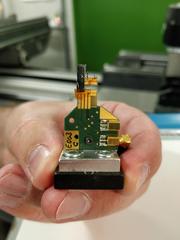URL: https://www.desy.de/news/news_search/index_eng.html
Breadcrumb Navigation
DESY News: Defects in solar cells don’t necessarily affect electricity generation
News
News from the DESY research centre
Defects in solar cells don’t necessarily affect electricity generation
An international team of researchers led by DESY has been investigating the correlation between defects in the material and the power generated by a solar cell, at an unprecedented resolution. The team used a range of experimental techniques to obtain its surprising results, which it has now published in the journal Advanced Science: defects, which inevitably arise when manufacturing so-called CIGS cells, can reduce their power output, but the effect is much less common and much more localised than expected.
CIGS cells essentially consist of copper, indium, gallium and selenium, which are applied in a thin layer that is only around two thousandths of a millimetre thick. This thinness not only helps to conserve resources; unlike conventional crystalline solar cells, CIGS cells are also flexible, making them suitable for a wide range of applications. The problem is that as CIGS cells are being manufactured, usually by vapour deposition of several different layers on a substrate, small regions known as voids form in the electricity-generating absorber layer, which might affect the power generation of the cell. The research team has now investigated this relationship in detail.

Similar to this sample, the solar cell was mounted on a dedicated sample holder for the measurements. Photo: DESY, M. Stuckelberger
The team then used the P06 beamline of DESY’s high-performance X-ray source PETRA III to analyse how much electricity is generated in exactly which areas of the solar cell. At the same time, they were able to analyse the local chemical composition of the sample using X-ray fluorescence – again collecting this data at the highest spatial resolution. By combining all this information, the researchers were then able to come to a surprising and encouraging conclusion: “If electricity generation is reduced, then this actually occurs in the immediate vicinity of the voids,” says Stuckelberger. “However, we also saw that most of the voids had hardly any impact on the cell’s power production.”
Nevertheless, the researchers also realised that the X-ray sources available today limit their ability to study nanoscale defects in solar cells and draw systematic conclusions about how they work. The group hopes that the greater brightness and higher resolution of new light sources, such as PETRA IV, will further improve the explanatory power of their experiments.
Reference
G. Fevola, C. Ossig, M. Verezhak, J. Garrevoet, H. L. Guthrey, M. Seyrich, D. Brückner, J. Hagemann, F. Seiboth, A. Schropp, G. Falkenberg, P. S. Jørgensen, A. Slyamov, Z. I. Balogh, C. Strelow, T. Kipp, A. Mews, C. G. Schroer, S. Nishiwaki, R. Carron, J. W. Andreasen, M. E. Stuckelberger: „3D and Multimodal X-Ray Microscopy Reveals the Impact of Voids in CIGS Solar Cells“ Adv. Sci. 2023, 2301873. https://doi.org/10.1002/advs.202301873



